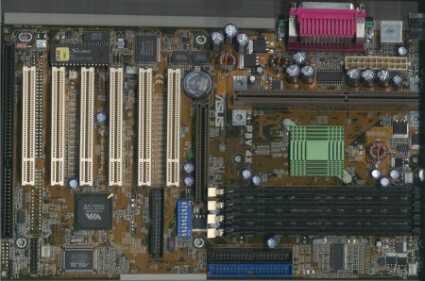21 Slot-1 Motherboards using VIA Chipsets
Asus P3V4X
Board Revision: 1.02
BIOS Version: 1003
There's hardly anybody who wouldn't know the name Asus. One of their rather enjoyable habits is to make excellent motherboards, although this habit goes along with a less enjoyable higher-than-average price tag. Due to lots of features and fast performance, the P3V4X is heading towards the very top again. From the features side of view Asus also seems to be one of the top candidates: The list starts with the common wake stuff (Wake On LAN, Wake On Ring... each one can be enabled individually), temperature and voltage monitoring, I/O connectors (2 serial, 1 parallel, two USB), IR connector and six PCI slots (instead of only five plus the AMR) and AGP 4x. According to the manual, all of them are PCI masters. As an alternative, the board can also be equipped with five PCI slots and two instead of one ISA slot. The PCI slots can be assigned one single IRQ each.
Asus also provides the maximum of four DIMM sockets (supporting ECC) and the option to set the CPU parameters either by using the DIPswitches or directly in the BIOS. The list of FSB speeds is quite long indeed: 66, 68, 75, 80, 83, 100, 103, 105, 110, 112, 115, 120, 124, 133, 140, 150, 155, 160 and 166 MHz. As the VIA chipset does not bear really high bus speeds, 150 MHz is the fastest setting which works reliably. The core voltage can additionally be modified in 0.05V increments.
Two DIPswitches are for the AGP speed setting: Auto, 1/1, 1/2 or 2/3 are your choices. This way you get the option to specifically overclock the AGP. In case you should have PCI cards, which do require their own IRQ, you can assign an IRQ to every PCI slot. Further you may enable or disable the AGP Fast Writes and configure the power button: Do you want it to activate suspend mode or to power down the system? The next feature is described best with another question: Where do you want to boot (from) today? Chose between FDD, HDD, LS120, CDROM, ZIP, MO, Network or SCSI.
Asus provides a full set of cables, including both 40 and 80 pin IDE plus an excellent manual. Just the CPU retention brackets have not been pre-installed. Still I have to complain about the place where Asus placed the FDD connector. Usually the cable will cover the front section of the graphics board. As most cards produce a lot of heat, this could possibly become a hot affair. Last but not least I think that a better labeling of the connector panel would be quite helpful for the assembly.
Once again we have to congratulate Asus, since the P3V4X was the best performer, rock stable and ready for all manner of expansion.
Get Tom's Hardware's best news and in-depth reviews, straight to your inbox.

Patrick Schmid was the editor-in-chief for Tom's Hardware from 2005 to 2006. He wrote numerous articles on a wide range of hardware topics, including storage, CPUs, and system builds.
